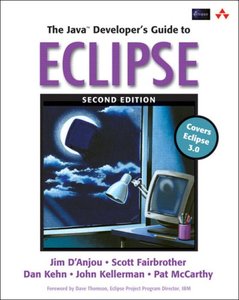Eclipse 4 Plug-in Development by Example: Beginner's Guide
暫譯: Eclipse 4 外掛開發實例:初學者指南
Dr Alex Blewitt
- 出版商: Packt Publishing
- 出版日期: 2013-06-24
- 售價: $1,690
- 貴賓價: 9.5 折 $1,606
- 語言: 英文
- 頁數: 348
- 裝訂: Paperback
- ISBN: 1782160329
- ISBN-13: 9781782160328
-
相關分類:
Java 相關技術
海外代購書籍(需單獨結帳)
買這商品的人也買了...
-
電力電子學 (Power Electronics, 3/e)
$580$522 -
 鳥哥的 Linux 私房菜-基礎學習篇, 3/e
鳥哥的 Linux 私房菜-基礎學習篇, 3/e$820$648 -
 深入淺出 Python (Head First Python)
深入淺出 Python (Head First Python)$780$616 -
 Android 4.X 手機/平板電腦程式設計入門、應用到精通, 2/e (適用 Android 1.X~4.X)
Android 4.X 手機/平板電腦程式設計入門、應用到精通, 2/e (適用 Android 1.X~4.X)$520$411 -
 Android 遊戲程式開發攻略-動手撰寫你的第一支 Android 遊戲程式 (Learning Android Game Programming: A Hands-On Guide to Building Your First Android Game)
Android 遊戲程式開發攻略-動手撰寫你的第一支 Android 遊戲程式 (Learning Android Game Programming: A Hands-On Guide to Building Your First Android Game)$480$379 -
實戰雲端作業系統建置與維護-VMware vSphere 5 虛擬化全面啟動
$680$537 -
 The C Programming Language, 2/e (IE-Paprback)
The C Programming Language, 2/e (IE-Paprback)$1,800$1,764 -
 Windows Server 2012 系統建置實務
Windows Server 2012 系統建置實務$680$537 -
 超圖解 Arduino 互動設計入門 (附 Arduino UNO R3 開發板)
超圖解 Arduino 互動設計入門 (附 Arduino UNO R3 開發板)$1,130$961 -
24 小時不打烊的雲端服務:專家教你用 Windows Server 2012 Hyper-V 3.0 實戰虛擬化技術
$880$686 -
 Arduino UNO R3 開發板(副廠相容版)附傳輸線
Arduino UNO R3 開發板(副廠相容版)附傳輸線$400$380 -
 Windows Server 2012 網路與網站建置實務
Windows Server 2012 網路與網站建置實務$680$537 -
 Binary Hacks -- 駭客秘傳技巧一百招
Binary Hacks -- 駭客秘傳技巧一百招$580$458 -
 HTML5 + CSS3 智慧型手機專用網站設計
HTML5 + CSS3 智慧型手機專用網站設計$450$356 -
 $2,328Linux System Programming: Talking Directly to the Kernel and C Library, 2/e (Paperback)
$2,328Linux System Programming: Talking Directly to the Kernel and C Library, 2/e (Paperback) -
 CSS3 網頁設計優化-新手也能快速建立跨平台網頁 (CSS3 Foundations)
CSS3 網頁設計優化-新手也能快速建立跨平台網頁 (CSS3 Foundations)$480$408 -
 C : How to Program, 7/e (IE-Paperback)
C : How to Program, 7/e (IE-Paperback)$1,300$1,274 -
 Eclipse RCP / Spring OSGi 技術詳解與最佳實踐
Eclipse RCP / Spring OSGi 技術詳解與最佳實踐$540$459 -
 眼球運動視力鍛鍊-只要每天 5 分鐘,不可思議的眼肌鍛鍊法
眼球運動視力鍛鍊-只要每天 5 分鐘,不可思議的眼肌鍛鍊法$349$297 -
 透視 C語言指標-深度探索記憶體管理核心技術 (Understanding and Using C Pointers)
透視 C語言指標-深度探索記憶體管理核心技術 (Understanding and Using C Pointers)$480$379 -
 動手玩科學:邊玩邊學的兒童教育(Tinkering: Kids Learn by Making Stuff)
動手玩科學:邊玩邊學的兒童教育(Tinkering: Kids Learn by Making Stuff)$380$342 -
 超簡單機器人動手做: 用隨處可見的材料發掘最先進的機器人學問 (Making Simple Robots: Exploring Cutting-Edge Robotics with Everyday Stuff )
超簡單機器人動手做: 用隨處可見的材料發掘最先進的機器人學問 (Making Simple Robots: Exploring Cutting-Edge Robotics with Everyday Stuff )$420$378 -
 Data Science from Scratch|用 Python 學資料科學 (中文版)(Data Science from Scratch: First Principles with Python)
Data Science from Scratch|用 Python 學資料科學 (中文版)(Data Science from Scratch: First Principles with Python)$580$458 -
Python 新手使用 Django 架站的 16堂課 - 活用 Django Web Framework 快速建構動態網站
$690$538 -
 jQuery 最強圖解實戰講座
jQuery 最強圖解實戰講座$450$383
相關主題
商品描述
How to develop, build, test, package, and release Eclipse plug-ins with features for Eclipse 3.x and Eclipse 4.x
Overview
- Create plug-ins to extend the Eclipse runtime covering Eclipse 3.x and the changes required for Eclipse 4.x
- Plug-ins from design to distribution — wide coverage of the entire process
- No prior OSGi or Eclipse plug-in development experience necessary
In Detail
As a highly extensible platform, Eclipse is used by everyone from independent software developers to NASA. Key to this is Eclipse’s plug-in ecosystem, which allows applications to be developed in a modular architecture and extended through its use of plug-ins and features.
"Eclipse Plugin Development by Example: Beginner's Guide" takes the reader through the full journey of plug-in development, starting with an introduction to Eclipse plug-ins, continued through packaging and culminating in automated testing and deployment. The example code provides simple snippets which can be developed and extended to get you going quickly.
This book covers basics of plug-in development, creating user interfaces with both SWT and JFace, and interacting with the user and execution of long-running tasks in the background.
Example-based tasks such as creating and working with preferences and advanced tasks such as well as working with Eclipse’s files and resources. A specific chapter on the differences between Eclipse 3.x and Eclipse 4.x presents a detailed view of the changes needed by applications and plug-ins upgrading to the new model. Finally, the book concludes on how to package plug-ins into update sites, and build and test them automatically.
What you will learn from this book
- How to create plug-ins for Eclipse 3.x and 4.x and automatically test plug-ins with JUnit
- How to display tree and table information in views
- What are the specific differences between the Eclipse 3.x model and the Eclipse 4.x model
- How and when to build user interfaces from SWT and JFace
- How to run tasks in the background and update the user interface asynchronously
- How to build plug-ins, features and update sites with Maven Tycho and automate user interface tests with SWTBot
- How to store and obtain preferences, and how to integrate with the Preferences panel
- How to work with the Eclipse resources model for creating and updating files and reporting errors to the user
Approach
A Beginner's Guide following the "by Example" approach. There will be 5-8 major examples that will be used in the book to develop advanced plugins with the Eclipse IDE.
Who this book is written for
This book is for Java developers who are familiar with Eclipse as a Java IDE and are interested in learning how to develop plug-ins for Eclipse. No prior knowledge of Eclipse plug-in development or OSGi is necessary, although you are expected to know how to create, run, and debug Java programs in Eclipse.
商品描述(中文翻譯)
如何開發、建置、測試、打包和發佈具有 Eclipse 3.x 和 Eclipse 4.x 功能的 Eclipse 插件
概述
- 創建插件以擴展 Eclipse 執行環境,涵蓋 Eclipse 3.x 及其對 Eclipse 4.x 所需的變更
- 從設計到分發的插件 — 廣泛涵蓋整個過程
- 不需要先前的 OSGi 或 Eclipse 插件開發經驗
詳細內容
作為一個高度可擴展的平台,Eclipse 被從獨立軟體開發者到 NASA 的各種使用者所使用。這一切的關鍵在於 Eclipse 的插件生態系統,該系統允許以模組化架構開發應用程式,並通過使用插件和功能進行擴展。
《Eclipse 插件開發實例:初學者指南》帶領讀者完整體驗插件開發的過程,從介紹 Eclipse 插件開始,經過打包,最終達到自動化測試和部署。示例代碼提供簡單的片段,可以進行開發和擴展,讓您快速上手。
本書涵蓋插件開發的基本知識,使用 SWT 和 JFace 創建用戶界面,與用戶互動以及在背景中執行長時間運行的任務。
基於示例的任務,例如創建和處理偏好設置,以及進階任務,如處理 Eclipse 的檔案和資源。專門的一章介紹了 Eclipse 3.x 和 Eclipse 4.x 之間的差異,詳細說明了應用程式和插件升級到新模型所需的變更。最後,本書總結了如何將插件打包到更新站點,並自動建置和測試它們。
您將從本書中學到的內容
- 如何為 Eclipse 3.x 和 4.x 創建插件,並使用 JUnit 自動測試插件
- 如何在視圖中顯示樹狀和表格信息
- Eclipse 3.x 模型和 Eclipse 4.x 模型之間的具體差異
- 如何以及何時從 SWT 和 JFace 建立用戶界面
- 如何在背景中執行任務並異步更新用戶界面
- 如何使用 Maven Tycho 建立插件、功能和更新站點,並使用 SWTBot 自動化用戶界面測試
- 如何存儲和獲取偏好設置,以及如何與偏好設置面板集成
- 如何使用 Eclipse 資源模型創建和更新檔案,並向用戶報告錯誤
方法
一本遵循「實例」方法的初學者指南。本書將使用 5-8 個主要示例來開發使用 Eclipse IDE 的進階插件。
本書的讀者對象
本書適合熟悉 Eclipse 作為 Java IDE 的 Java 開發者,並有興趣學習如何為 Eclipse 開發插件。不需要先前的 Eclipse 插件開發或 OSGi 知識,但您應該知道如何在 Eclipse 中創建、運行和調試 Java 程式。



































